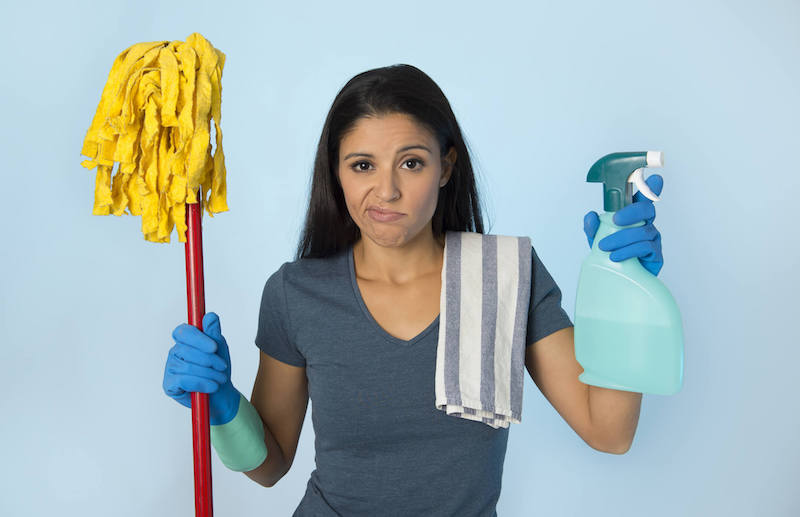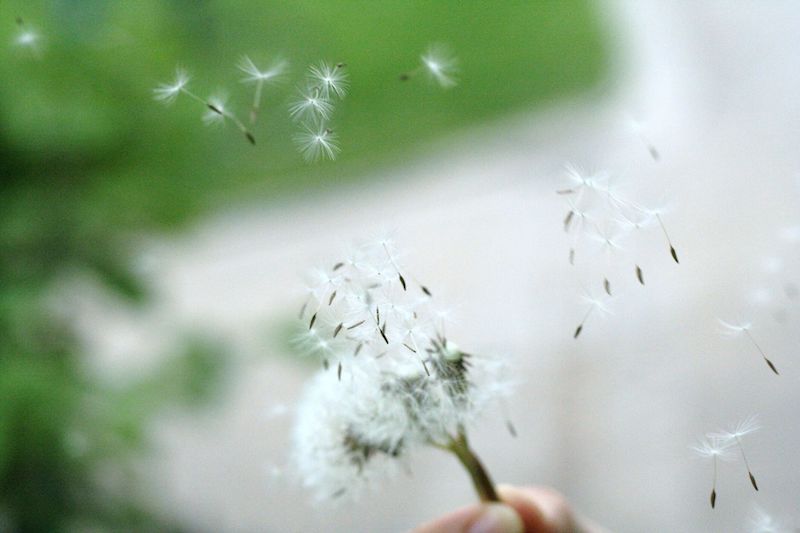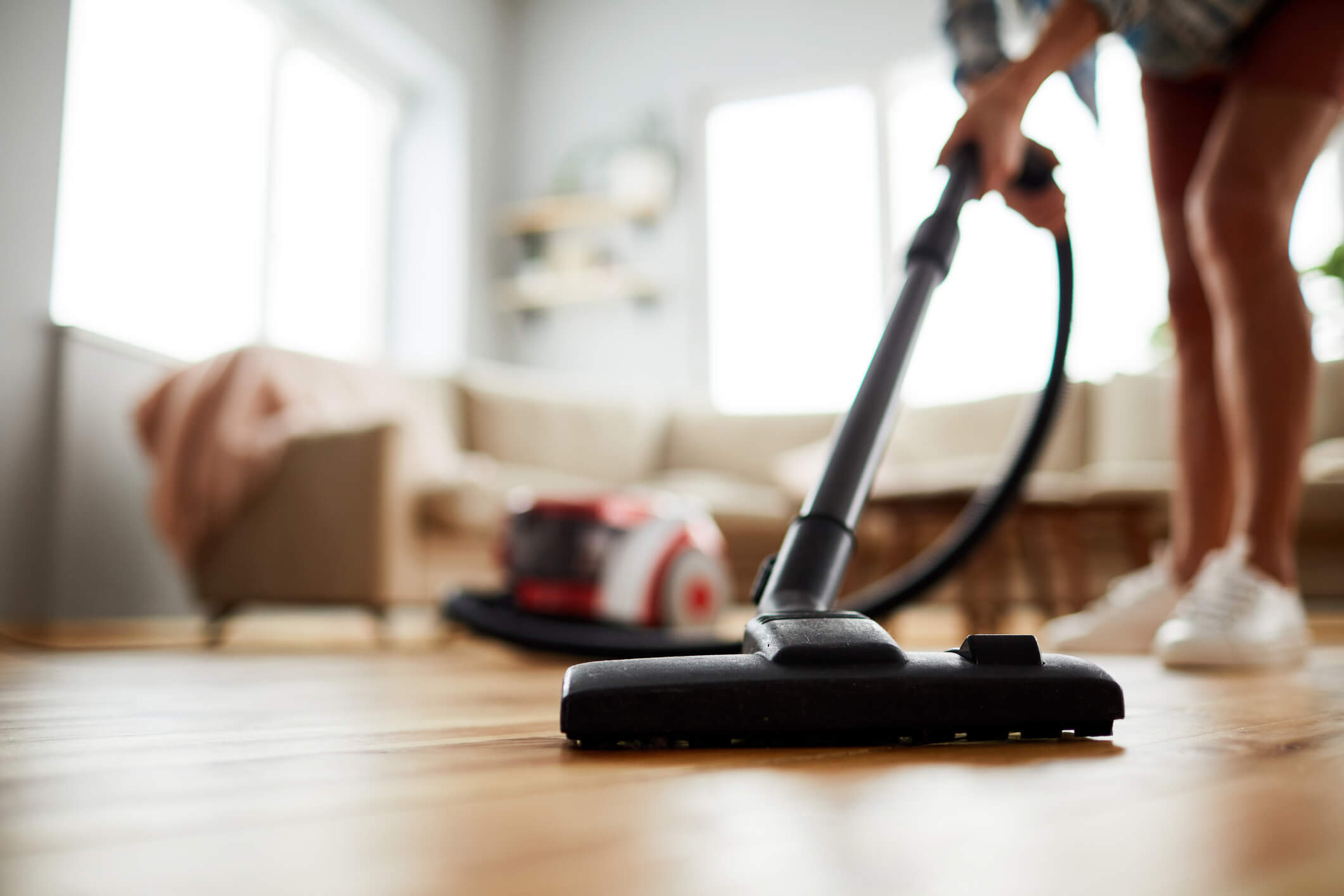There probably aren’t very many people who genuinely enjoy cleaning. Sure, we all love that amazing fresh smell, the mental sigh of relief from everything being put back in place, and that killer feeling of accomplishment from a monumental job being completed. After spending all week working and checking off the million and one tasks of everyday life, though, getting the house in order can be a bit of a pain. Unfortunately, that pesky fungus among us does not care about our feelings or perpetual exhaustion. Cleaning to remove mold contamination may not be something you want to do, but it’s something you absolutely should do!

When it's for your health, it's worth the work!
Not only that, adding annual or biannual deep cleaning to your home maintenance routine schedule is a great addition to your mold prevention action plan. The fewer moldy particles in a home there are, the less chance one has of stumbling on a nice little place to put down roots. Also, the better the indoor air quality will be, which is a plus-plus for your health.
So, let’s all channel our inner cleaning machines and get our indoor environments in tip-top shape.
The Why of Cleaning to Remove Mold Contamination
We already know that cleaning isn’t a favorite chore, so why in the heck would we want to jump right in and get to work? Much less, adding it to the yearly chore calendar?
In short, because mold contaminates a home like a confetti cannon filled with glitter blasting off in an arena. Imagine one of those machines going off right inside of your own home, and you’ve got the right idea. That stuff would get everywhere, just like this fungus among us, except most of those moldy particles are invisible!
To get you on board with cleaning to remove mold contamination, it’s best to know why this necessary evil is important.
Mold: A Short Story
There are two parts to mold: the living part and the non-living part. This is important to keep in mind!
Over 100,000 species of mold have been identified so far, and they reproduce by creating microscopic particles called spores.¹’² It’s similar to how a dandelion puff releases those fluffy white seeds. Like seeds, these spores are not alive. They need the right conditions to transition into a living organism.
These components for life include:³
- Oxygen (they require very little, which is why they can live inside walls)
- Temperature (40-90 degrees Fahrenheit is ideal, but some species can survive in extremes)
- Food (they eat almost anything)
- Moisture (the often missing ingredient)

If they land on a surface that has all of these aspects for at least 24 hours, that spore will transition into a living organism. As soon as mold begins to grow, it will put down roots on that surface and start to produce more and more of those spores.
Some species of mold can also produce microscopic toxins called mycotoxins when they feel threatened, creating a contamination particle bomb in the surrounding area.⁴ What an overachieving fungus, right?
So, what’s the hoopla about this information? Getting rid of a mold problem doesn’t just involve killing and removing the living mold. All of those dead moldy particles, spores, toxins, and sometimes bacteria (depending on the source of the water event) hanging out also contribute to ongoing exposure. And, they’re probably all over the house now as well because they have no boundaries. That’s why all particles need to be actively kicked to the curb.
Indoor Mold Growth: A Tragedy
Mold growth in nature plays a huge role in helping along with important natural processes such as decomposition. Go mold! This outdoor mold also doesn’t typically trigger any issues for us humans. We’ll encounter a few spores and toxins throughout the day, but it’s no biggie. However, mold exposure indoors causes an entirely different situation, and it can happen to any home, at any time.
Our homes can easily provide each of the four components for life listed above. A hidden leak under the bathroom sink, for example, creates the perfect living situation for a lucky mold spore. Once that spore comes in contact with this life-giving surface, it will immediately put down roots and flourish, and a thriving mold colony equals a serious contamination issue for you and your family.

Picture that confetti cannon filled with glitter. When that glitter bomb goes off, the particles somehow find their way into every crack, crevice, and surface it can find. To make matters worse, they’ll also stick to shoes, clothing, and even the pet’s fur and tag along for the ride outside of that initial glitter bombed room.
A mold colony creates a similar situation, except the particles are invisible to the naked eye and are terrible for your health. Spores (and sometimes toxins) will ride the air current throughout that initial room and wherever else it leads, from the living room all the way into the basement. That’s why one moldy issue can quickly spiral into three or four in the blink of an eye.
As long as the mold continues to grow, those particles will continue to spread all around the space and stick to whatever surface they come in contact with. Couches, beds, coffee tables, kitchen utensils, books… Nothing is safe from these microscopic contaminants.
Current building practices for homes also don’t help the situation. Building tighter, more energy-efficient homes often inhibit airflow between inside and outside the home, which means all of those particles remain trapped within the walls of the building.
It’s like living inside of a snow globe filled with mold. A mold globe, if you will. As you can imagine, our immune systems do not appreciate this level of contamination.
Mold Exposure: A Tale of Horror
When the body faces a mold particle or toxin, the immune system will deploy and immediately get rid of it. A couple of particles throughout the day? Usually not a problem. A moldy army of particles? That’s a huge ask for our poor immune systems. They’ll do their best to fight off the onslaught from the air and surfaces around the home, but continued exposure often leads to immune systems that are run down, malfunctioning, or falling behind. An unhappy immune system leads to an unhappy body, which leads to an unhappy you.
The truth is, though, no two immune systems react to mold the same way. Researchers are still trying to nail down exactly how mold affects the body, but it’s a tricky subject to figure out. Aspects such as genetics, species of mold, presence of mycotoxins, length of exposure, and immune system status all play a role. Those with a developing or compromised immune system, for instance, often experience adverse health reactions from exposure faster and to a greater extent.⁵’⁶’⁷’⁸

Symptoms of exposure also vary based on the individual. While one person may only develop a runny nose, another may begin to suffer from chronic fatigue, digestive issues, brain fog, hair loss, rashes, and mood swings. Sometimes, mold toxicity will also work with or trigger autoimmune conditions such as Lyme disease, Candida, or PANS/PANDAS, which opens up another wormy can of potential symptoms.
The opportunity for mold-related illness shows why properly remediating and cleaning to remove mold contamination is so important. Until that contamination is removed, any symptoms will persist. Not to mention, removing mold particles can also prevent a fungus situation from happening in the first place.
It’s a win-win!
The When of Cleaning To Remove Mold Contamination
There’s never really a bad time to start cleaning to remove mold contamination, but there are some specific times that absolutely necessitate it so exposure stops.
A Current Mold Problem
If a mold problem already exists in your home, prepare to embark on the biggest sanitization journey of your life. It sounds extreme, but decontaminating the home entails a lengthy, but necessary, process to ensure you and your family are safe.
Remember, once that fungus begins to grow, moldy particles will get everywhere- all over that initial room, other areas of the home, and on the surfaces of belongings.
To make matters worse, remediation to fix and remove the issue also stirs up the moldy pot and moves the particles all around the house. This doesn’t mean the remediation team isn’t doing their job correctly; it’s just a byproduct of the process. That’s why individuals often misuse the widely popular ERMI testing method. Unless someone incorporates proper cleaning and timing of use, this tool will not be effective in helping to create a picture of the status of the indoor environment. Make sure to watch this video so that you know when and how to use this measuring method.
Also, keep in mind that an ERMI test is not the end-all-be-all when it comes to mold levels in a home; it’s a single tool in the toolbox.⁹
The remediation team you choose should fully understand ERMI testing as well as how to solve your mold problem. This includes fixing the source that led to the issue in the first place and getting rid of all of the contamination produced by the mold. Solving the mold issue and handling the contamination in that area doesn’t take care of the larger problem in the home, though. Glitter bomb, remember? That’s where channeling the inner clean machine comes in, so the contamination is limited and exposure reduced.
Here’s when you should start cleaning to remove mold contamination:
A) Before remediation: This removes as many particles as possible that may get kicked up from the removal process. The fewer moldy particles there are, the less chance that more items in the home will become contaminated, like the couch downstairs. Refer back to the ERMI video for a great demonstration of how these particles will get whirlwinded throughout the home.
B) During remediation: This is like the clean-as-you-go phase. Again, particles will continue to get kicked up from other places in the home and can land on any surface. Not to mention, they’ll muck up the air quality. Actively working to remove them can prevent as much cross-contamination as possible and keep the air healthy.
C) After remediation: Think about glitter. Once there’s glitter in the home, you’ll continue to find it even years after the shimmery event. Mold particles are the same way, especially since they’re microscopic! There might not be a mold factory in the house anymore, but the particles it created got into every crack and crevice in the place. You’ve got to continually work to remove them from all of the surfaces and items in the home as they randomly get kicked up and moved around the space.
There’s no getting around it; cleaning to remove mold contamination will be a pain, but it’s a necessary pain! Kind of like going to the dentist for a root canal. We all hate it, but we’ll go every time to ensure we don’t go through life toothless. Similarly, removing all of the moldy contamination from your home ensures that there's not an invisible threat lurking around causing mayhem to your poor immune system.
Annual Prevention
The best way to solve a mold problem is to prevent it from occurring in the first place. Unfortunately, for those of us that hate cleaning, this involves a deep dive into sanitizing the home.
Even without an existing mold colony in a house, spores and toxins can fly right in the door at any time or catch a ride on clothing, bags, and the pet’s fur. You may not see them hanging around, but that doesn’t mean they’re not there! And like dust, they’ll continue to build up and build up until they’re removed. Again, picture that moldy snow globe image.

By actively removing them from an indoor environment, you’re improving the indoor air quality, reducing the number of particles the immune system has to fight off, and lessening the chance of a moldy colony developing inside. It’s pretty much a moldy hat trick for your home.
Scheduling this deep cleansing annually is great, but the more frequently you clean, the safer and healthier the indoor space will be.
The How of Cleaning To Remove Mold Contamination
Knowing the why and when of cleaning to remove mold contamination won’t be very useful unless you know how to properly clean for mold! There’s nothing worse than actually taking the time to cleanse the home and finding that the contamination inside isn’t removed… Talk about a tragedy.
The Tools
First things first, you can’t embark on your cleaning journey until you have the right tools for the job. The tricky thing about mold particles is their size. Normal cleaning products can leave these little contaminants behind, even if you’re actively working to get rid of them. You’re going to want to build a cleansing arsenal that can genuinely remove moldy particles.
HomeCleanse recently released a Home Detox Box that’s packed full of everything needed to begin properly cleaning every inch of your home. Who doesn’t love taking the guesswork out of choosing the right products!
Cleaning Fun Fact #1: Bleach should NOT be the cleaning product you use!!! Even the EPA says so. ¹⁰
To get started, you’ll need cleaning tools that can handle mold particles. These will include items such as:

- A HEPA vacuum cleaner: This will remove at least 99.7% of particles up to 0.3 microns in size (the smaller it can remove, the better).¹¹
- Botanical cleaning products: These items, like Benefect Decon 30, will effectively remove the moldy particles from surfaces and won’t trigger mold to release mycotoxins. Not to mention, the lack of harsh chemicals makes them much safer to use.
- An air scrubber: This will remove teeny-tiny particles from the air that got kicked up from cleaning. Remember that the smaller particles it can remove, the better. And, it should remove them all the time, not just some of the time.
- Microfiber towels: These are 100 times more effective at removing small particles than regular towels.
- Protective gear: This will shield you from the particles that are kicked up from cleaning. Your immune system will thank you!
The Home Detox Box comes with the best of each of these products, plus directions on how to use them properly.
The Process
Cleaning to remove mold contamination involves cleaning the surfaces of the home and the belongings inside.
Safety note: When it comes to belongings contaminated by mold, it’s always best to err on the side of caution, especially if you or a family member have experienced exposure-induced symptoms. For belongings directly in the crossfire of the growing mold, get rid of as many items as you comfortably can. Decontaminating them isn’t foolproof, and particles can remain even after extensive cleaning. For whole-home mold problems, this can seem especially daunting, but when health is on the line, it’s worth it.
Also, belongings should be covered or removed during remediation to limit cross-contamination as much as possible.
To start, decide on which surface you’re working with:
- Porous: liquid absorbs into them, such as clothing, lampshades, and carpet
- Non-porous: liquid pools on top of them, such as finished wood, sealed countertops, and glass
- Semi-porous: some liquid pools on top and some seeps into it, such as unsealed wood, leather furniture, and some plastic
From there, make a plan of attack for cleaning to remove mold contamination based on that particular surface. First things first, though: put on your protective gear and turn on the air scrubber.
Cleaning Fun Fact #2: If you have an existing mold issue, repeat every cleaning process at least three times. Mycotoxins and bacteria are particularly difficult to remove from surfaces.
Steps for cleaning porous surfaces include:
- Throwing machine washable items in with an EPA-approved cleaning product like EC3 Laundry Additive
- Vacuum every inch with the HEPA vacuum, including corners and crevices.
Health tip: These are the surfaces and items that are prone to retaining contamination. Particles can seep into the fibers of the items and be impossible to remove, even after extensive cleansing. They’ll be the top contenders for things you should remove from the home and replace.
Steps for cleaning non-porous surfaces include:
- Vacuum the entire surface using the HEPA vacuum.
- Spray the surface with an EPA-approved cleaning product like Benefect Decon 30.
- Allow the cleaning product to sit for at least 10 seconds before wiping away with the microfiber towel.
- Allow the surface to dry completely.
Thoroughness is the name of the game when it comes to cleaning to remove mold contamination, so clean rigorously and frequently.

If you’re ever in doubt about cleaning or anything else moldy, contact an expert to give you some guidance.
Mr. Clean Knows What’s Up
Learning why, when, and how to tackle cleaning to remove mold contamination will be some of the most important moldy awareness facts in your arsenal. The more contamination you work to remove, the healthier the home will be. Surfaces will be decontaminated, the indoor air quality will be top-notch, and the likelihood of a mold problem developing drops. Not to mention the peace of mind you’ll gain!
Cleaning to remove mold contamination is an intensive process, but it’s crucial to help ensure you and your family are living in a clean and safe environment.
Health begins at home.™
Citations:
- Environmental Protection Agency. (n.d.). Mold. EPA. Retrieved from https://www.epa.gov/mold.
- Centers for Disease Control and Prevention. Basic facts about mold and dampness. Centers for Disease Control and Prevention. Retrieved from https://www.cdc.gov/mold/faqs.htm.
- Lstiburek, J., Brennan, T., & Yost, N. (2002, January 15). Rr-0208: What you need to know about mold. Building Science Corporation. Retrieved from, https://www.buildingscience.com/documents/reports/rr-0208-what-you-need-to-know-about-mold/view.
- World Health Organization. (n.d.). Mycotoxins. World Health Organization. Retrieved from https://www.who.int/news-room/fact-sheets/detail/mycotoxins.
- Environmental and Occupational Health Assessment Program, & Environmental and Occupational Health Assessment Program, & Health Science Section, Mold Basics for Primary Care Clinicians (2009). Hartford, CT; Connecticut Department of Public Health. , H. S. S., Mold Basics for Primary Care Clinicians 1–10 (2009). Hartford, CT; Connecticut Department of Public Health.
- Curtis, L., Lieberman, A., Stark, M., Rea, W., & Vetter, M. (2004). Adverse health effects of indoor molds. Journal of Nutritional & Environmental Medicine, 14(3), 261-274.
- Bush, R. K., Portnoy, J. M., Saxon, A., Terr, A. I., & Wood, R. A. (2006). The medical effects of mold exposure. Journal of Allergy and Clinical Immunology, 117(2), 326-333
- Fisk, W. J., Lei-Gomez, Q., & Mendell, M. J. (2007). Meta-analyses of the associations of respiratory health effects with dampness and mold in homes. Indoor air, 17(4), 284-296.
- EPA. (n.d.). Environmental Relative Moldiness Index (ERMI). EPA. Retrieved October 21, 2021, from https://www.epa.gov/air-research/environmental-relative-moldiness-index-ermi.
- EPA. (n.d.). Should I use bleach to clean up mold? EPA. Retrieved from https://www.epa.gov/mold/should-i-use-bleach-clean-mold
- EPA. (n.d.). What is a HEPA filter? EPA. Retrieved from https://www.epa.gov/indoor-air-quality-iaq/what-hepa-filter-1.

